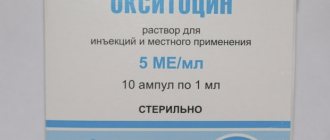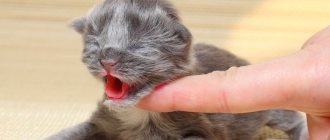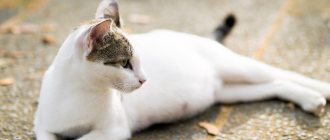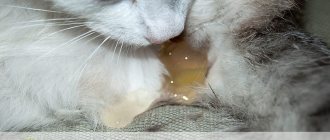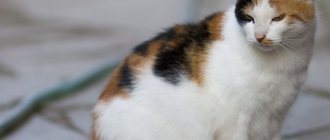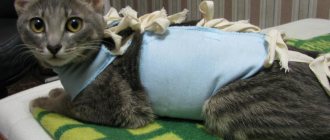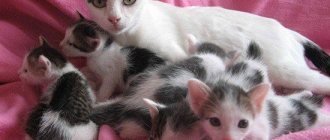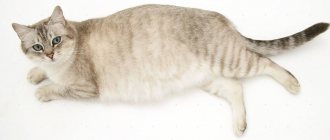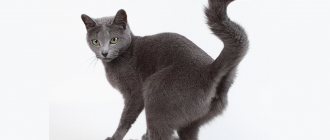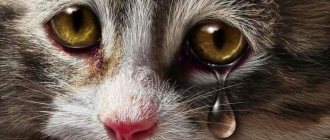11/13/2021 11,638 Diseases and treatment of cats
Author: Olga
The birth of kittens is one of the most important events in the life of a pet and an equally important moment for the cat owner. Particular attention should be paid to caring for a cat after birth. What to do if there is discharge and blood or mucus comes from the animal’s genitals? What to do in such cases? You can find out more in this article.
[Hide]
Normal discharge after childbirth
As you know, several hours of labor are very stressful for a cat. But the next ten days will be no less intense. What discharge is considered “normal” after giving birth to a cat?
The cat's body must recover within ten days. Only after this period the animal will be able to lead a full life. At this time, discharge from the pet's genitals is common; in general, the process of discharge can occur over a period of three weeks.
When kittens suckle milk, this is an integral part of the recovery process of the cat's body. When milk is produced, the uterus contracts, which at this time expels all harmful bloody mucus and other types of secretions from the animal’s body. It will be worse if the cat does not have milk; accordingly, all the mucus will not be able to actively leave the body, which can subsequently harm the pet.
If, immediately after giving birth, you notice that bloody or dark brown with green particles are coming out of the cat’s vagina, then this is also a normal situation. In most cases, this discharge becomes mucous in nature after a few days and may become more transparent or slightly pink. As a rule, such discharge has, so to speak, a “metallic” smell - remember, there is nothing wrong with this, this is the norm. But if the smell is different, uncharacteristic, then it’s time to take the cat to the doctor.
If you want to control the color and volume of bloody discharge, then place a white sheet in the cat's nest. If the discharge continues for more than three weeks or less than seven days, then this is a reason to seek help from a doctor. The health of your pet is paramount, especially if the cat is feeding kittens.
Pay attention to the animal's genitals - if the cervix has not closed completely within ten days, this can cause serious infections to enter the body.
Clinical picture and diagnosis
As we have already said, the white color of the discharge often indicates the presence of purulent inflammation in the animal’s body. Since the latter in itself has a serious impact on the health of the animal, it is not surprising that the discharge is accompanied by obvious clinical signs:
- The cat constantly licks the genital area.
- The skin and mucous membranes of the external genitalia are inflamed and swollen.
- The animal may rub its butt against the floor or walls (due to severe itching). This is often confused with manifestations of helminthic infestations.
- As a rule, due to constant itching and pain in the genitals, the cat strains all the time, which is accompanied by frequent urination and defecation. In severe cases, defecation may be spontaneous, and the cat leaves puddles of urine and piles of feces throughout the house.
- Increased overall body temperature and increased thirst.
Accordingly, to make a diagnosis (taking into account various reasons) it will not be possible to do only with a visual examination. Complex complex diagnostics will be required:
- A complete, detailed blood and urine test will be required.
- It is necessary to sow secretions and scrapings from the vaginal walls onto nutrient media. This way you can find out exactly what you have to deal with this time.
- Microscopic and cytological examination of scrapings from the vaginal walls.
- Ultrasound examination and fluoroscopy of the pelvic organs and/or the entire abdominal cavity are strongly recommended.
- Vaginoscopy. If the result reveals any pathological neoplasms on the walls of the vagina, a biopsy is required.
- Serological studies of blood plasma aimed at identifying infectious diseases.
- A complete check of the condition of the urinary system is required.
“Dangerous” discharge in a cat after childbirth
Today, the drug Oxytocin is considered obsolete among some veterinarians. However, more than half of the doctors from the former CIS countries have not yet abandoned its use. Oxytocin is a medicine that helps stimulate contractions. Its most significant disadvantage is that if used during childbirth, it can cause uterine rupture. Accordingly, the safest option for using this drug is to administer it during expulsion of the placenta, when the kittens have already been born.
- If after giving birth a cat begins to have bright bloody discharge with Oxytocin, then in 99% of cases this indicates a rupture of body tissues. If you are giving birth yourself and decide to give your cat this drug, then you need to take the animal to the doctor as soon as possible or call him home. The veterinarian chooses measures to solve this problem based on the situation. For example, if the bleeding is dripping, but quite heavy, then the cat will need to be given a hemostatic medicine. If the bleeding is very severe, then this is already considered a loss of blood, in which case nothing other than surgery will help.
- Even if you have not used Oxytocin, heavy bleeding for more than ten minutes can even cause death. Accordingly, in this case you will also need the help of a specialist.
- If bloody discharge with green particles, but very thick, comes out of the cat’s genitals, then this is also a bad sign. This indicates inflammation of the uterus. As a rule, the primary reason for this is unsanitary conditions or illness, that is, infection. In addition, this may be a consequence of incomplete release of the placenta or a dead kitten in the womb. As you understand, a dead fetus remaining in the tummy will one way or another cause the appearance of pus and, accordingly, intoxication of the animal. Therefore, in this case, there are two options - if it is the remains of the placenta, then it is necessary to use antibiotics, if the fetus is dead, then only surgical intervention.
- If the discharge from the uterus after childbirth has acquired a greenish, yellowish or gray tint, then this is also a bad sign. As a rule, in such cases, the animal is diagnosed with inflammation of the uterus. It is a very dangerous disease; if you do not take time to treat it in time, the death of your pet is inevitable. If the damage to the uterus is very severe, then there is no other way out except its complete removal. In such cases, the diagnosis can only be made by a qualified doctor who will perform an ultrasound on the cat, and the born kittens will need to be transferred to artificial nutrition.
- If, after childbirth, discharge with blood and breast milk comes out of the genitals, this may indicate inflammation of the mucous membrane of the genitourinary system or only the genitals. This disease is very dangerous for a weakened cat who has had to undergo childbirth. If the stage is initial, then the treatment may be more gentle, that is, the kittens will not need to be taken away from the cat.
Sorry, there are no surveys available at this time.
Before you begin any treatment, you should be fully aware of the information about your pet's breed. Perhaps the breed itself is problematic in terms of childbirth. If this is so, then treatment with antibiotics or any operations may even have a sad outcome - perhaps the cat simply will not be able to physically feed the kittens.
When to see a doctor
An attentive and loving owner will immediately notice disturbances in the cat’s behavior and the presence of abnormal discharge after delivery.
Reasons to consult a doctor are:
- Putrid smell.
- Duration of discharge (more than 2 weeks).
- The appearance of white curdled flakes.
- Bleeding or blood clots.
- Feeling unwell with apparently normal discharge.
If any of these signs occur, you should immediately visit a doctor.
Rules for caring for a cat during the postpartum period
The postpartum period is very important for a cat. What to do to make the animal feel good and the feeding process go smoothly? You will learn about this below.
Hygiene
Hygiene is the first thing you need to pay attention to. As mentioned above, it is necessary to carefully monitor the color and nature of postpartum discharge, and if necessary, wipe the area under the cat’s tail. As a rule, pets after giving birth are already clean - they remove all the mucus themselves, but there are exceptions. But if the cat has just given birth, then she may be too weak to take care of herself.
You also need to pay attention to the place where the cat and kittens lie. To avoid infections that are associated with unsanitary conditions, the area should always be clean. Change the sheets regularly, preferably when the cat goes to the toilet or eats, so as not to disturb its psychological peace.
Peace, only peace
For some time after giving birth, your pet and litter need peace and quiet. Psychological health should be given maximum attention, so it is recommended to place the cat and kittens in a box, which should be placed in a separate room. It is advisable that it be quiet there, and in principle it is not recommended to go there, except perhaps for a person who will monitor the condition of the animal.
Neither adults, nor especially children, should be allowed to touch small kittens. Your pet may behave very unpredictably after this. The cat may stop recognizing the kittens, she may lose milk, or she may even take her offspring to another place and hiss at everyone who tries to approach. Moreover, there have been cases when a cat herself killed kittens, believing that it would not be possible to raise them in such difficult conditions.
Nutrition
One type of food for nursing cats is high-quality Royal Canin
In order for your pet to recover faster during the postpartum period, and therefore for the kittens to feed normally, she must eat enough. The same goes for water. If a cat has brought more than three kittens, then she will eat at least twice as much at a time as usual. This is not fraught with damage to your figure, because all the food consumed will be used to produce milk.
On the first day after giving birth, the cat may not eat anything at all, this is not scary. During this period, she, as a rule, worries about her offspring and pays all her attention exclusively to the kittens. However, your task is to provide the woman in labor with food and drink. You should place bowls of food and water next to the box in which the mother and her offspring are located, because she may express a desire to eat at any time.
As for the diet itself, it is recommended to work it out with a veterinarian. If the cat has always eaten natural food, then the diet must be carefully planned, since a deficiency or excess of a particular substance can negatively affect its health. But if you fed the cat only dry food, then there will be fewer problems. Today, stores sell a wide variety of foods for nursing pets.
If your pet does not eat for more than a day, then you should consult a doctor, because if the cat’s health is normal, then her appetite will be very strong.
Temperature control
You should also monitor your pet’s body temperature, that is, it should be measured periodically, at least once a day, preferably two or even three times. If the animal's temperature is below 38 degrees or above 39, this is very bad. The first thing to do is take your cat to the doctor. If the temperature is above 39 degrees, then most likely this indicates an infection that can kill not only the offspring, but also the mother herself. If the temperature is very low, then this may be a consequence of internal bleeding.
Treatment
Treatment tactics directly depend on the cause of pathological discharge from the uterine cavity.
If the abnormal discharge is caused by an uncomplicated infection, treatment may be conservative. It is enough to undergo a course of drug therapy to cure the disease.
Surgical treatment is necessary in all other cases: rupture of the birth canal, incomplete release of the membranes, aggressive course of the infection. Emergency care after lambing is necessary when the cat has uterine bleeding. If nothing is done, this could be fatal.
Video “Birth of a kitten”
We do not recommend watching this video for impressionable or faint-hearted people - it shows the process of giving birth to a kitten and how the cat cares for it immediately after birth.
Was this article helpful?
Thank you for your opinion!
The article was useful. Please share the information with your friends.
Yes (100.00%)
No
X
Please write what is wrong and leave recommendations on the article
Cancel reply
Rate the benefit of the article: Rate the author ( 3 votes, average: 5.00 out of 5)
Discuss the article:
What is the norm
Discharge from a cat's loop after birth is not always associated with pathology. After all, after bearing kittens, the uterus must recover. This usually happens in 7-10 days. But often the recovery period lasts up to three weeks. This is usually observed in older animals. And during all this time, discharge is observed. If their number is small, then this should not be a cause for concern.
Normally, discharge in cats after birth in the first days may have different colors. If over time the color of the discharge becomes transparent, then there is no need to worry about the cat’s health. These are particles of placenta and excess epithelium coming out of the uterus. This phenomenon is considered normal and does not indicate a disease.
Purulent discharge
Purulent discharge in a cat after birth is especially dangerous. They have a thick consistency. The color of the exudate can vary: from yellowish to gray. Most often this is a sign of pyometra. In such cases, urgent examination and treatment by a veterinarian is necessary. Purulent inflammation of the uterus can lead to the death of the animal. In addition, purulent discharge may be a sign of endometritis or tumors of the genitourinary system. These diseases are extremely dangerous as they can cause blood poisoning.
Diagnostics
Pathological postpartum discharge in animals can be caused by various reasons. To identify the etiology of this symptom, the following examinations are prescribed:
- general and biochemical blood test;
- clinical and bacteriological analysis of urine;
- vaginal smear examination;
- examination of the genital tract using a colposcope;
- Ultrasound of the abdominal organs;
- X-ray of the kidneys with contrast agent;
- blood clotting study.
